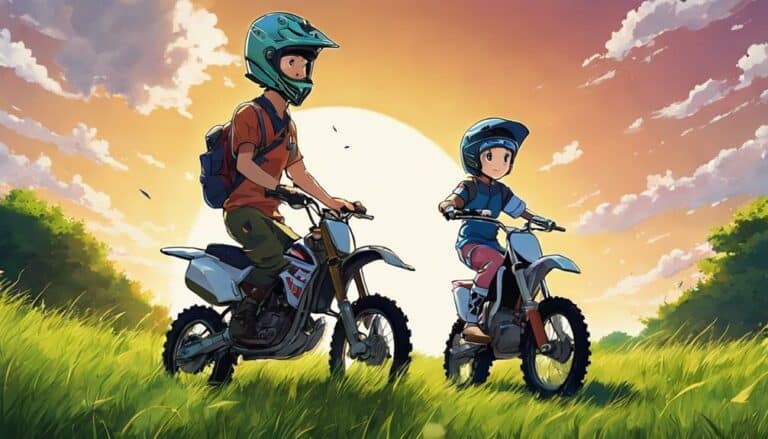When teaching a child to ride a dirt bike, it's important to contemplate their physical size and strength. Did you know that selecting the right bike size can greatly influence their learning experience and overall safety?
By ensuring the bike fits them well, you set the stage for a smoother and more enjoyable introduction to riding.
Now, let's explore how this critical first step can pave the way for a successful dirt biking journey for your child.
Key Takeaways
- Choose the right size bike for child's age and size
- Ensure proper safety gear like helmet and pads
- Teach basic riding techniques focusing on control
- Set clear rules, boundaries, and supervision for safe riding
Choosing the Right Size Bike
When selecting the appropriate dirt bike size for a child, always consider their age and size to guarantee a safe and comfortable riding experience. One vital factor to prioritize is the seat height of the bike. Look for a bike with a seat height that allows the child to touch the ground with both feet firmly planted. This guarantees stability and control when coming to a stop or maneuvering tricky terrain. The child should be able to reach the ground easily while seated on the bike to prevent any awkward balancing acts that could lead to accidents.
Additionally, it's essential to make sure that the child can comfortably reach the handlebars and controls while sitting on the bike. This ergonomic consideration not only enhances the riding experience but also promotes safe handling of the dirt bike. By choosing a bike that allows the child to have both feet on the ground and easy access to the controls, you set them up for a successful and enjoyable riding adventure.
Safety Gear Essentials
Consider outfitting your child with the necessary safety gear before they set off on their dirt bike riding journey. This includes a proper helmet, goggles, gloves, chest protector, knee pads, and riding boots. Here are four key safety gear essentials to prioritize:
- Helmet: Protects the head in case of falls or collisions, reducing the risk of severe head injuries.
- Goggles: Shield the eyes from debris, dust, and wind, ensuring clear vision throughout the ride.
- Gloves: Improve grip on the handlebars, offer hand protection, and reduce the risk of blisters during extended rides.
- Chest Protector and Knee Pads: Shield essential organs and joints from impact, minimizing the risk of injuries to the chest and knees.
Ensuring your child wears the proper safety gear isn't only essential but also a critical step in promoting a safe and enjoyable dirt bike riding experience. Quality gear enhances confidence, comfort, and overall safety, making it a worthwhile investment to prevent injuries and foster responsible riding habits from the start.
Learning Basic Riding Techniques
To begin mastering the art of riding a dirt bike, focus on honing fundamental skills like throttle control and body positioning. Practice controlling the throttle smoothly to accelerate and decelerate with precision. Proper body positioning is important for maintaining balance and control while riding. When shifting gears, make sure to use the clutch effectively to smoothly switch between speeds.
Mastering slow-speed maneuvers like sit-down turns will help you build essential riding skills and confidence on the bike. Learn the proper techniques for balance, turning, and braking to improve your overall riding ability.
Incorporate exercises such as skidding the rear tire to enhance your control and understanding of bike dynamics. Practice both standing up and sitting down riding techniques to adapt to different riding situations and various terrains. Remember, the key to becoming a skilled dirt bike rider is consistent practice and a focus on refining these basic riding techniques.
Setting Rules and Boundaries
Establishing clear rules and boundaries is crucial for ensuring safe and responsible dirt bike riding practices. When setting rules and boundaries for your child's dirt bike riding adventures, consider the following:
- Establish Clear Riding Areas: Define specific locations where your child is allowed to ride the dirt bike. This guarantees they stay within safe zones.
- Set Speed Limits: Determine appropriate speed limits based on your child's skill level and the terrain. Enforcing speed restrictions enhances safety.
- Prioritize Safety Gear: Emphasize the importance of safety gear such as helmets, gloves, goggles, and protective clothing. Ensure your child wears these items each time they ride.
- Supervision and Consequences: Supervise your child closely while they ride to provide immediate assistance if needed. Additionally, establish consequences for not following the rules to instill discipline and promote responsible riding habits.
Regular Maintenance Tips
Regularly maintaining your dirt bike is essential to guarantee peak performance and longevity. To keep the bike in top condition, change the oil and oil filter every 10-15 hours of riding. This practice ensures proper engine lubrication, leading to improved performance. Additionally, cleaning and greasing the chain regularly is critical to prevent wear and tear, ultimately ensuring smooth power transmission.
Before each ride, make sure to check the tire pressure. Maintaining ideal tire pressure is important for achieving maximum traction and handling on various terrains. Inspecting the air filter frequently is also significant. Clean or replace it as needed to prevent debris from entering the engine, which could cause damage over time.
Lastly, don't forget about the brakes. Regularly inspect the brake pads, brake fluid, and brake rotors for wear and proper function. This will guarantee your dirt bike has the necessary stopping power for a safe ride.
Conclusion
Now that you have equipped your child with the right size dirt bike, safety gear, and basic riding techniques, remember that practice makes perfect. Just like a young sapling needs time to grow strong roots before flourishing into a majestic tree, your child needs time to develop their riding skills.
By setting rules, boundaries, and prioritizing regular maintenance, you're nurturing their growth and ensuring they've a safe and enjoyable dirt biking experience. Keep nurturing their skills like a gardener tending to their garden, and watch them bloom into confident riders.

